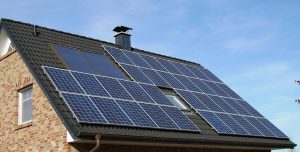Photovoltaic energy is, no doubt, one of the most sustainable alternatives for electric power production at the moment. Thanks to many government incentives, made available to individuals and companies, photovoltaic power has become even more popular than the past.

One thing is sure: thanks to photovoltaic systems, we will be able to produce enough energy required to power our houses or even our businesses. This represents one of the main reasons why many people decided to convert to photovoltaic energy. In most cases, people opted for the classic panels to be installed on the roof or the ground. Thanks to the many recent technological innovations that developed new projects, photovoltaic cells can now be used in a different way.
Photovoltaic asphalt: the new frontier of sustainability

When talking about renewable energy, photovoltaic asphalt represents one of the most ambitious projects.
In France, this is already a reality and let’s hope this model will be soon extended to other member states of the EU and not only. The way the photovoltaic asphalt works is not that different from that of conventional panels. Panels are positioned below the asphalt, capture sunlight, and convert it into electrical energy.
As you can imagine, external disruptions represent the greatest risk. For the more suspicious minds, the transit of cars and of different modes of transport could appear as the most critical issue. In reality, panels are protected by a substrate that does not make them so vulnerable. Photovoltaic cells are rigorously made of polycrystalline silicon, are very easy to install and are above all, very resistant.
It is important to highlight that these cells last for approximately 20 years. The photovoltaic asphalt can provide electrical energy to about 5 million people. For this reason, it represents a valid alternative that goes beyond the simple production of photovoltaic energy for domestic use.
Energy generating windows

A valid alternative to photovoltaic panels are traditional windows capable of generating energy.
Here again, we are dealing with a definitely original application of PV. The so-called photovoltaic windows are capable of producing electric energy even though they are less efficient than traditional photovoltaic panels. However, it is worth mentioning that they are very easy to install and are definitely less expensive.
You only need five years to ensure that the investment is paid off. Transparent photovoltaic cell: this is the name given by technicians to these unique windows. More specifically, photovoltaic windows can be made with silica gel, organic polymers or even with graphene.
Many companies opted for organic photovoltaic (OPV) cells. Its constituents are not that expensive and do not require excessive energy. Furthermore, transparency is guaranteed. You can also apply a very thin film on the surface of the windows; however, in this case, it is necessary to opt for the silica gel. In this respect, before choosing the most suitable photovoltaic solution, you should consider the specific needs and requirements of the property.
At the moment, the one disadvantage of these windows is represented by the fact that traditional systems can be sloped while windows cannot. Due to the windows location, energy production is drastically reduced.
Combining photovoltaics with cars
Cars represent for sure one of the most exciting innovations within the photovoltaic industry. As you might have guessed, electric cars have been the subjects of several experiments. At the moment, there are only a few spots available where you can recharge your electric car in main cities. For this reason, there was the need to create a new way for powering this kind of cars, with no need to connect them to the electric grid.
Transform solar energy into electrical energy seemed to be the best solution. The idea that comes from the United States is to apply a special film on both, the windscreen and the windows, in such a way as to be able to capture uniformly the sunlight, so that it can be transformed into electrical energy. Obviously, these films are transparent and therefore will not be a nuisance to drivers. If desired, these same films can be applied to every kind of object. Why would you not use them on your smartphone or tablet to allow your devices to auto recharge? In this regard, it necessary to remember that we are still at the beginning of the project.
The capacity of the films to store solar energy represents a problem. It seems that the films are less efficient compared to conventional panels. Ford was the first trying to partially power a car with photovoltaics. Both, fuel and electricity power the car.
However, at Ford, they did not opt for applying films to the car windows; but on the contrary, they have installed photovoltaic panels on the roof. Special mirrors that capture more solar energy regardless of the panels ‘angle were fitted on the car. It is clear that photovoltaics is at a turning point and that the research will contribute expanding this technology to many different fields. The only thing we need to do now is to wait for future developments and hope that in the short term, we can benefit from these innovative projects.
